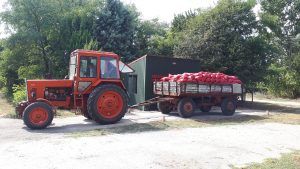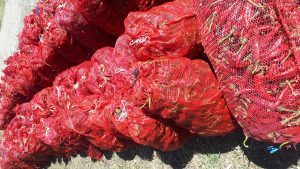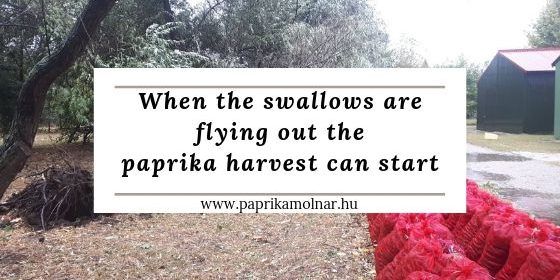According to tradition, last Sunday, September 8, paprika farmers reached a significant date. The Feast of the Nativity of the Blessed Virgin Mary is associated with the start of the paprika harvest. Around the city of Szeged, it was believed that the Swallow-chasing Lady sets out to chase the birds away from their homes thereby giving a signal to start harvesting.
Nowadays, due to climate changes, circumstances have changed considerably, the paprika havest can sometimes already happen at the end of August. This year at some places early fruits can already be picked, but the real yield is expected to come later. Our own farmers actually started this weekend and it will soon turn out if they were made the right timing.
As we mentioned earlier, this year’s extremely hot August caused fast maturation at the expense of weight gain, farmers therefore expect lower yields.
Unfortunately, the climate conditions this year were far from ideal in terms of harvest quantity: because of the cold rains in late May and early June we planted the seedlings relatively late and on top of that the few foggy mornings at the end of June did not help with the growing of the crop.
Harvesting paprika. Then and now
When you start harvesting paprika, there are some basic rules to follow, like our ancestors did. Paprikas should only be picked when the fruits are completely red. Only in this state you will get the quality-determining compounds such as dyes, essential oils, minerals and capsaicin which are responsible for the pungency of paprika.
Picking ripe paprikas is heavy, repetitive and back-breaking work. The fruits of the continuously growing paprikas ripen in stages, first you should pick the fruits at the bottom of the plant. Raw material of a good quality grind can be both from early-pick or from the second-pick.

Transport after paprika harvest
By manual picking you can increase the quality of harvest. This way you can immediately detect the sunburned, sick, or possibly “sooty” (semi-immature) fruits from the right ones which are really red. Machine picking can be applied when the fruits reached the same level of ripeness pretty much at the same time. Such basic grind however is below the quality of that from a hand-picked paprika harvest.
After harvest maturation
Although harvested paprikas do look completely red, they are in fact dominated by yellow and orange. This is because paprika, being of tropical origin, is not really fully maturing in our European climate. Therefore, it is worthwhile to extend the ripening process after the harvest. During this so called post-ripening process, we ensure the truly intense red color of the grind.
Post-ripening is nowadays mostly done in Raschel bags, but it is also possible that large quantities of fruits are spread on a large courtyard to expose the fruits to some late Summer sunlight. The authentic method, of course, was to string the paprikas on garlands and hang them out under the eaves.
Also during the post-ripening period, we remain vulnerable to the weather, as with other aspects of cultivation. The massive storm that happened a few days ago proves that unexpected events can occur at any time. A prolonged rainy season can cause a lot of damage, while a long, warm autumn would provide great grind for next season. So we keep hoping for the best weather and will be back with the latest news soon!

Post-ripening in Raschel bags
Tetszett a cikk? Ha szeretne még paprikás és fűszeres témában, heti rendszerességgel cikket olvasni, hírt kapni az ÚJ paprika elkészültéről, iratkozzon fel hírlevelünkre. Subscribe to our Blog and enjoy our Paprika Poster.







